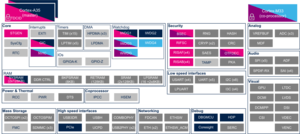1. Article purpose[edit | edit source]
The purpose of this article is to:
- briefly introduce the OTFDEC peripheral and its main features,
- indicate the peripheral instances assignment at boot time and their assignment at runtime (including whether instances can be allocated to secure contexts),
- list the software frameworks and drivers managing the peripheral,
- explain how to configure the peripheral.
2. Peripheral overview[edit | edit source]
The OTFDEC peripheral is used to decrypt data on read request. The peripheral is used on top of an OCTOSPI to allow on the fly decryption of associated data from connected mass storage.
Refer to the STM32 MPU reference manuals for the complete list of features, and to the software frameworks and drivers, introduced below, to see which features are implemented.
3. Peripheral usage[edit | edit source]
This chapter is applicable in the scope of the OpenSTLinux BSP running on the Arm® Cortex®-A processor(s), and the STM32CubeMPU Package running on the Arm® Cortex®-M processor.
3.1. Boot time assignment[edit | edit source]
3.1.1. On STM32MP2 series[edit | edit source]
Click on ![]() to expand or collapse the legend...
to expand or collapse the legend...
| Domain | Peripheral | Boot time allocation | Comment | |||
|---|---|---|---|---|---|---|
| Instance | Cortex-A35 secure (ROM code) |
Cortex-A35 secure (TF-A BL2) |
Cortex-A35 non-secure (U-Boot) | |||
| Security | OTFDEC | OTFDEC1 | ⬚ | ⬚ | ||
| OTFDEC2 | ⬚ | ⬚ | ||||
3.2. Runtime assignment[edit | edit source]
3.2.1. On STM32MP25x lines  [edit | edit source]
[edit | edit source]
Click on ![]() to expand or collapse the legend...
to expand or collapse the legend...
| Domain | Peripheral | Runtime allocation | Comment | |||||
|---|---|---|---|---|---|---|---|---|
| Instance | Cortex-A35 secure (OP-TEE / TF-A BL31) |
Cortex-A35 non-secure (Linux) |
Cortex-M33 secure (TF-M) |
Cortex-M33 non-secure (STM32Cube) |
Cortex-M0+ (STM32Cube) | |||
| Security | OTFDEC | OTFDEC1 | ⬚OP-TEE | ⬚ | ⬚ | ⬚ | ||
| OTFDEC2 | ⬚OP-TEE | ⬚ | ⬚ | ⬚ | ||||
4. Software frameworks and drivers[edit | edit source]
Below are listed the software frameworks and drivers managing the OTFDEC peripheral for the embedded software components listed in the above tables.
| Coming soon |
5. How to assign and configure the peripheral[edit | edit source]
The peripheral assignment can be done via the STM32CubeMX graphical tool (and manually completed if needed).
This tool also helps to configure the peripheral by generating:
- partial device trees (pin control and clock tree) for the OpenSTLinux software components,
- HAL initialization code for the STM32CubeMPU Package.
The configuration is applied by the firmware running in the context in which the peripheral is assigned.
| Coming soon |
6. How to go further[edit | edit source]
| Coming soon |
7. References[edit | edit source]
